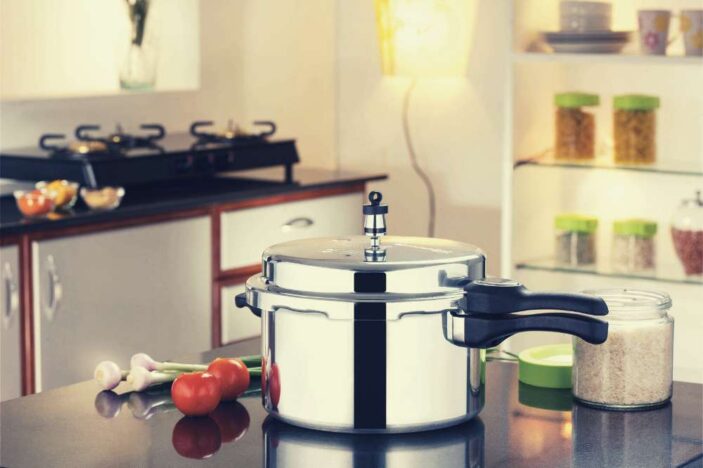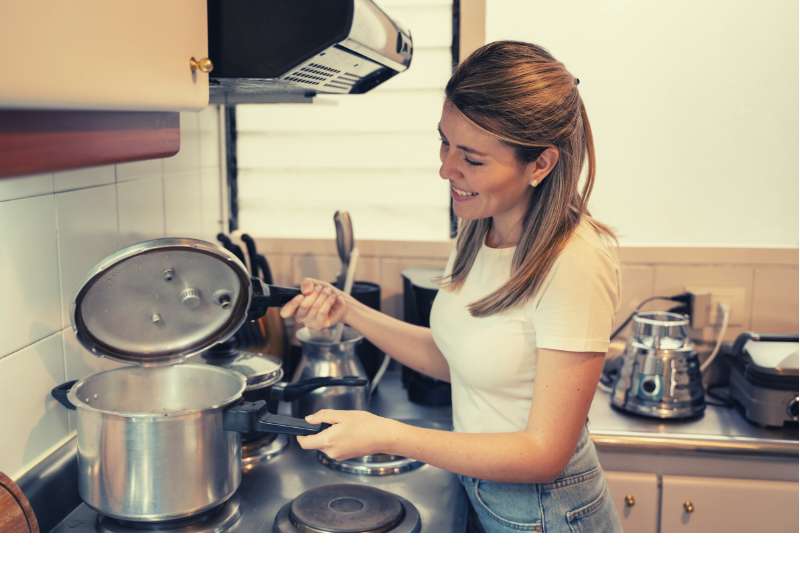Welcome to the world of pressure cooking! You’re in for a treat if you’re new to this cooking method. A pressure cooker can save you time and effort while producing delicious, nutritious meals.
But how to use a pressure cooker?
In this article, we’ll guide you through everything you need to know about using a pressure cooker.
From unboxing and inspecting your pressure cooker to cleaning and maintaining it, we’ll cover all the steps necessary for successful pressure cooking.
So let’s get started!
Getting Started with Your Pressure Cooker

Getting started on the right foot is important if you’re new to pressure cooking. Here are the steps you should take to ensure success:
Unboxing and Inspecting Your Pressure Cooker
- Carefully unpack your pressure cooker and inspect it for any signs of damage or defects.
- Check that all parts are present and in good condition.
Reading the Instruction Manual
- Thoroughly read the instruction manual that came with your pressure cooker.
- Pay close attention to any safety instructions and specific features of your model.
Familiarizing Yourself with the Parts of the Pressure Cooker
- Identify the various parts of your pressure cooker, including the lid, gasket, pressure release valve, and handles.
- Understand how each part functions and how they fit together.
Ensuring Your Pressure Cooker is Clean and Ready to Use
- Wash all parts of your pressure cooker in warm, soapy water before using it for the first time.
- Ensure that the pressure cooker is free from any debris or foreign objects.
- If there are any visible signs of damage or wear, have it checked by a professional before using it?
By following these steps, you’ll understand how to use your pressure cooker safely and effectively.
Preparing Ingredients for Pressure Cooking
Preparing ingredients for pressure cooking is an important step that can impact the taste and texture of your final dish. Here are some tips to keep in mind:
Choosing the Right Ingredients for Pressure Cooking
- Choose ingredients that can handle high-pressure cooking, such as tough cuts of meat, legumes, and root vegetables.
- Avoid ingredients that may become mushy or overcooked, such as delicate fish or leafy greens.
Properly Washing and Cutting Ingredients
- Wash all fruits and vegetables thoroughly to remove any dirt or debris.
- Cut ingredients into uniform pieces to ensure even cooking.
- Avoid overcrowding the pressure cooker, which can lead to uneven cooking and may even cause the pressure cooker to malfunction.
Adjusting Cooking Times and Liquid Amounts for Different Ingredients
- Follow recipes carefully, as cooking times and liquid amounts may vary depending on the ingredients used.
- Use the minimum amount of liquid required for the recipe, as pressure cooking requires less liquid than traditional cooking methods.
By properly preparing your ingredients, you’ll be able to achieve the best possible results when using your pressure cooker.
How to Use a Pressure Cooker Correctly

Now that you’ve prepared your ingredients, it’s time to start using your pressure cooker. Here’s how to do it:
Adding Ingredients and Liquid
- Add your prepared ingredients to the pressure cooker pot.
- Pour in the required amount of liquid, ensuring it does not exceed the maximum fill line.
Securing the Lid and Setting the Pressure Level
- Secure the lid onto the pressure cooker pot, ensuring it is properly aligned and locked.
- Set the pressure level to the desired setting, depending on the recipe and ingredients.
Heating and Cooking
- Turn on the heat and wait for the pressure indicator to reach the desired level.
- Once the desired pressure level is reached, lower the heat to maintain the pressure level for the required cooking time.
- Follow the recipe’s instructions for releasing pressure and opening the lid safely.
Troubleshooting Common Issues
- If you experience any issues with your pressure cooker, such as steam escaping from the lid, refer to the instruction manual for troubleshooting steps.
- Common issues can often be resolved by adjusting the pressure level, checking the seal, or adding more liquid.
Following these steps, you can easily use your pressure cooker to cook delicious and nutritious meals.
Cleaning and Maintaining Your Pressure Cooker
Properly cleaning and maintaining your pressure cooker is important to ensure its longevity and safe use. Here are some tips to keep in mind:
Cleaning After Each Use
- Always wash your pressure cooker thoroughly after each use, including the lid, gasket, and pot.
- Use warm, soapy water and a non-abrasive sponge or cloth to avoid damaging the surface.
- Never immerse the base of the pressure cooker in water.
Removing Stains and Burnt Residue
- Soak the pressure cooker in warm, soapy water for several hours to remove stubborn stains or burnt residue.
- For more stubborn stains, try using a paste of baking soda and water to scrub the affected area gently.
Inspecting and Replacing Parts
- Regularly inspect the gasket, pressure release valve, and other pressure cooker parts for signs of wear or damage.
- Replace any damaged or worn parts immediately to avoid potential safety hazards.
Storing Your Pressure Cooker
- Store your pressure cooker in a cool, dry place away from direct sunlight and heat sources.
- Avoid stacking other heavy items on top of the pressure cooker, which can cause damage to the lid or gasket.
By following these tips, you can help ensure that your pressure cooker is always in good condition and ready to use when needed.
Conclusion
Congratulations! You now know how to use a pressure cooker to prepare delicious and nutritious meals in a fraction of the time compared to traditional cooking methods.
With the tips and techniques outlined in this article, you can make the most out of your pressure cooker and enjoy its many benefits.
Always read and follow the manufacturer’s instructions when using your pressure cooker, and never exceed the recommended maximum fill line. By properly caring for your pressure cooker, you can ensure its longevity and safe use for years.
So experiment with different recipes and ingredients, and enjoy the convenience and efficiency of pressure cooking.
Your taste buds (and possibly your schedule) will thank you for it!
FAQs
Here are the frequently asked questions related to using a pressure cooker.
Is It Safe To Use A Pressure Cooker?
Yes, pressure cookers are generally safe if you follow the manufacturer’s instructions and properly care for the appliance. Always ensure it does not exceed the maximum fill line and safely release pressure before opening the lid.
Can I Cook Anything In A Pressure Cooker?
While a pressure cooker is a versatile appliance that can cook various dishes, not all recipes suit pressure cooking. Generally, recipes that require long cooking times or contain delicate ingredients may not be suitable for pressure cooking.
How Much Liquid Should I Add To A Pressure Cooker?
The amount of liquid required for pressure cooking varies depending on the recipe and the ingredients used. Generally, you should add at least one cup of liquid to the pressure cooker and always stay within the maximum fill line.
How do I release pressure from a pressure cooker?
There are two methods for releasing pressure from a pressure cooker: natural and quick. The natural release allows the pressure to reduce independently, while quick-release manually releases the pressure by turning the pressure release valve.
How Do I Clean My Pressure Cooker?
After each use, you should clean your pressure cooker thoroughly, including the lid, gasket, and pot. Use warm, soapy water and a non-abrasive sponge or cloth to avoid damaging the surface. Never immerse the base of the pressure cooker in water.
Can I Cook Frozen Food In A Pressure Cooker?
While it is possible to cook frozen food in a pressure cooker, it is generally not recommended as it can affect the quality of the food and increase the cooking time. It is best to thaw the food completely before pressure cooking it.
